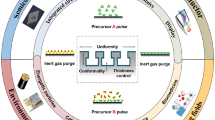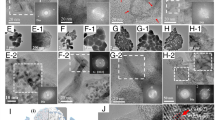Abstract
THERE are various techniques of vapour deposition for putting down thin films, or thicker coatings and deposits of one material on another1,2, which are of interest to a growing number of industries. The techniques range from chemical vapour deposition at relatively high gas pressure and temperature to physical vapour deposition based on thermal evaporation in a high vacuum for deposition on to hot or cold substrates. In recent years interest has grown in several intermediate techniques in soft vacuum (10−3 to 1 torr) which may be physical and/or chemical in nature3–5. Gas discharges are sometimes used to influence both the physical and chemical aspects of the process—to generate vapour by sputtering, to cause chemical reactions among vapour species, or to encourage bonding to the substrate. Here I outline the basic features of a new ‘intermediate’ technique which depends simply on evaporation into a heated gas. The aim is to cause the vapour species to diffuse to the substrate while avoiding conditions favouring homogeneous nucleation in the gas phase. Chemical reactions may or may not occur depending on the choice of gas and gas discharges can be employed for substrate cleaning, or other purposes if required.
Similar content being viewed by others
References
Powell, C. F., Oxley, J. H., and Blocher, J. M., Vapour Deposition (Wiley, New York, 1966).
Chopra, K. L., Thin Film Phenomena (McGraw Hill, New York 1969).
Sputtering and Ion Plating (edit. by Lundin, B. T.), Proc. Conf. on, Lewis Research Centre, 1972 (NASA SP-5111).
Kurtz, R. G., Vapor-Ion Methods of Film Deposition (Dow Chemical Co. 1970).
Keller, K., Härterei-tech. Mitt., 26, 120 (1971).
Reifenschweiler, O., Rev. Sci. Inst., 35, 456 (1964).
Avery, R. G., and Ramsay, J. D. F., J. Colloid Interface Sci., 42, 597 (1973).
Lothe, J., and Pound, G. M., in Nucleation (edit. by Zettlemayer, A. C.) p.118 (Dekker, New York, 1969).
McGinty, D. J., J. chem. Phys., 55, 580 (1971).
Sutugun, A. G., Phys. Lett., 29 A, 233 (1969).
Lydtin, H., Proc. 2nd Intern. Conf. on Chemical Vapour Deposition p.71 (The Electrochemical Society, 1970).
Dugdale, R. A., Nature, 220, 1179 (1968) and Glow Discharge Material Processing (Mills and Boon, ME/5, 1971).
Burns, R. M., and Bradley, W. W., Protective Coatings for Metals, third ed. (Reinhold, 1967).
Author information
Authors and Affiliations
Rights and permissions
About this article
Cite this article
DUGDALE, R. New vapour deposition technique. Nature 249, 440–441 (1974). https://doi.org/10.1038/249440a0
Received:
Revised:
Issue Date:
DOI: https://doi.org/10.1038/249440a0
- Springer Nature Limited
This article is cited by
-
Soft vacuum processing of materials with electron beams
Journal of Materials Science (1975)





